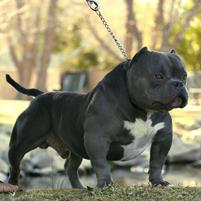EXOTIC BULLY BREED
STANDARD

FOREWORD
The Exotic Bully has been around since approximately 2013 as a breed recognized by the USBR, the first Exotic Bullies were American Bullies that were exclusive to a few bloodlines that concentrated on the more “bulldoggy” looking traits and were beyond the “standard” set up for the American Bully within other registries. The Exotic Bullies were cast out by those registries for not being American Bullies and not fitting their standards. During this time period there were other breeds that were brought into the Exotic Bullies that were not readily spoken about in the breed’s history which consists of American Bulldog, English Bulldog, Olde English Bulldog, and French Bulldog just to name a few that were added by certain bloodlines to enhance the look the breeders were trying to achieve above and beyond the original breed. Over the last few years the Exotic Bully is beginning to get a “desired” look that is becoming more consistent and this breed standard will serve as a standard for which they will be graded by with the goal of bringing more even consistency to the breed. We also recognize that the Exotic Bully is a continuing breed that still to this day has various looks defined by bloodline. This breed standard is to serve the breed in protecting its health as well as not preventing breeders from following their vision to create their version of the breed. This breed standard will be revisited in a few years for revision if necessary.
GENERAL IMPRESSION
The Exotic Bully should give the impression of great strength for its size, compact to medium/large size dog with a muscular body and blocky head. The Exotic Bully should have the appearance of heavy bone structure with a bully build, the breed is a “head and front breed” chest should be wide to match blocky head type. The Exotic Bully should NOT look like an American Bully.
EARS:
High set and may be natural or cropped without preference. Prick, or flat, wide ears are not desired.
Disqualifications:
Unilateral or bilateral deafness.
EYES:
All colors except albinism. Eye shape would be round to oval, low down in skull and set far apart.
Serious Faults:
Bulging eyes; both eyes not matched in color; blue eyes.
Disqualifications:
blindness in either or both eyes not caused by injury.
HEAD:
Medium length, deep through, broad skull, very pronounced cheek muscles, 90 degree skull stop, and high set ears.
Minor Faults:
skull stop is sloped more than 100 degrees but less than 135 degrees; narrow eyeset
Serious Faults:
skull stop is sloped more than 135 degrees.
MUZZLE:
Short rounded on upper side or squared to fall away abruptly below eyes. Jaws well defined. Under jaw to be strong and have biting power.
Faults:
Snipey muzzle; weak lower jaw.
LIPS:
semi-close and even
NOSE:
all colors acceptable.
TEETH/BITE:
A full complement of large, strong, white teeth meet in a scissor bite; slightly undershot bite accepted. The canines are wide apart; and the incisors are in an even, level row.
Minor Faults:
Teeth or tongue showing when the mouth is closed; overshot bite
Faults:
extremely overshot or undershot bite measuring more than one inch in either way.
NECK:
Heavy, slightly arched, tapering from shoulders to back of skull-minimal or no loose skin.
Faults: Neck too thin or weak.
SHOULDERS: Strong and muscular with blades wide.
BACK: Fairly short to medium back. Slight sloping from withers to rump or straight accepted with gentle short slope at rump from canadian pharmacy to base of tail. A slight fall off behind the shoulders to the beginning of the back, which is the lowest part of the entire topline is acceptable. (Desired) The length of the back should be approximately be the same as the height of the bully as measured in inches as measured from the withers to the croup.
Faults:
Back length overly disproportionate to the height of the bully.
BODY:
Deep and wide chest, deep in rear and all ribs close together. Forelegs set rather wide apart to permit chest development. Chest should be deep and broad with muscular mass.
TAIL:
Short to medium in comparison to size, low set, tapering to a fine point ending at the rear hock are preferred. A docked tail is acceptable and is preferred over a tail with kinks and knots. (EXCEPTION: Exotic Bullies that are shown or that reside in countries where docking of tails is either next to impossible or illegal; i.e. most European countries. In this regard a tail with a kink and/or knot will not have the fault held against them in the show ring.)
Minor Faults:
Kinks, knots, and short tails are accepted.
FRONT LEGS:
slightly bowed front legs, large and round bones, pasterns upright are preferred.
Faults:
Weak pasterns; knots on elbows
Serious Faults:
Extremely bowed front legs that inhibit fluid movement
FEET:
Should be of moderate size and compact. A slight turning outwards of the feet up to 15 degrees is accepted.
Faults:
Feet measuring between 15 and 45 degrees.
Serious Faults:
Feet measuring between 45 and 90.
Disqualifications:
Feet measuring beyond 90 degrees when stacked are disqualifying.
HINDQUARTERS:
are strong, muscular, and broad. The rump is well filled in on each side of the tail and deep from the pelvis to the crotch. The bone, angulation, and musculature of the hindquarters are in balance with the forequarters. The thighs are well developed with thick, easily discerned muscles. Viewed from the side, the hock joint is well bent and the rear pasterns are well let down and perpendicular to the ground. Viewed from the rear, the rear pasterns are straight and parallel to one another.
HIND LEGS:
strong and large; slightly longer than the forelegs, which elevates the loin above the shoulders is acceptable.
Faults:
Narrow hindquarters; hindquarters shallow from pelvis to crotch; lack of muscle; straight or over angulated stifle joint, cow hocks, and sickle hoc.
GAIT:
Should be effortless and powerful. The action must, however, be unrestrained, free and vigorous with powerful drive off the rear. Some paddling and lumber accepted. A bulldog “rolling” to the gait is acceptable. Regardless, the movement should appear efficient in motion.
COAT:
Glossy and smooth, close, and moderately stiff to the touch.
Faults:
Curly hair
Disqualifications:
Long coat.
COLOR:
All colors and patterns are accepted except the color merle.
Disqualifications:
the color merle
SIZE:
Height and weight should be in proportion to the dog and measured from the withers.
Varieties:
Micro: Male: 13.5” and under; Females: 13” and under
Standard: Male: above 13.5; Female: above 13”
Misc:
There are no weight limitations or requirements for the breed, but dogs should not be obese. An emphasis on overall movement is of the utmost priority with an understanding that the breed was created using American Bullies and Bulldogs.
Faults:
Skull stop is sloped more than 100 degrees but less than 135 degrees (serious fault beyond 135 degrees). Narrow eyeset bulging eyes. Both eyes not matched in color. Blue eyes. Kinks, knots, and short tails, long tails (see EXCEPTION above in this breed standard). Extremely overshot or undershot bites measuring more than one inch in either way. Snipey muzzle. Weak lower jaw. Severe turned fronts, front feet that are between 15 and 90 degrees. Neck too thin or weak. Back length overly disproportionate to the height of the bully. A coat with curly hair. Weak pasterns. Narrow hindquarters, hindquarters shallow from pelvis to crotch. Lack of muscle. Straight or over angulated stifle joint, cow hocks, and sickle hock. Aggressive behavior towards animals and humans
Disqualifications:
(A dog with a disqualification must not be considered for placement in a conformation event, and must be reported to USBR.)
Viciousness or extreme shyness. Unilateral or bilateral cryptorchid (one or both testicles have not dropped). Albinism. Merle. Blindness in one or both eyes not caused by injury. Unilateral or bilateral deafness. Feet beyond 90 degrees when stacked. Long coat
All USBR standards belong to the Bully Registry LLC and cannot be copies or changed without permission from the USBULLYREG.com group.








